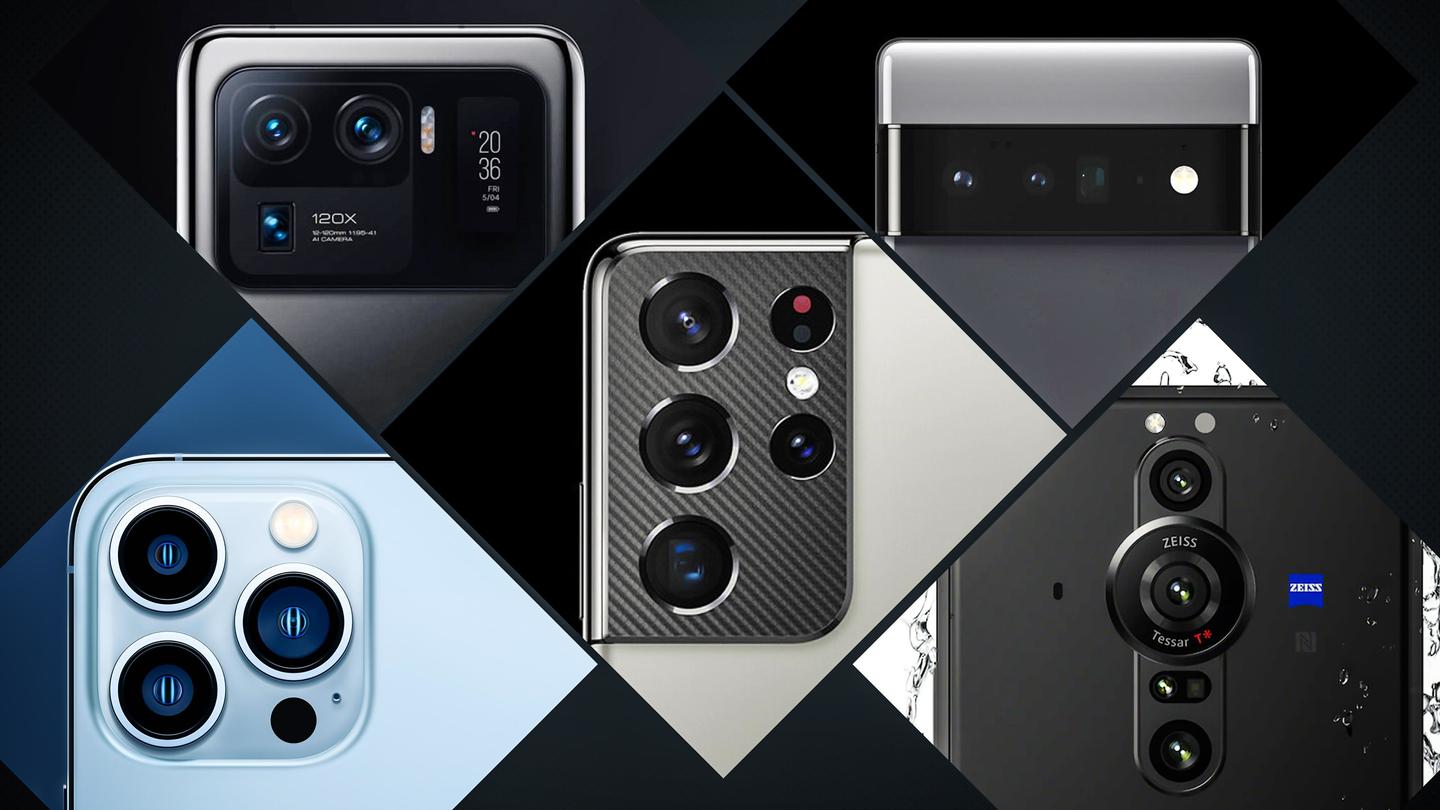
These are the top 5 camera smartphones of 2021
What's the story
Some can argue that the most important feature of a smartphone is its camera given how almost everyone is creating content on the go.
From 8K video support to providing Photoshop-like editing features, tech giants like Apple, Samsung, and Google have been constantly upgrading their smartphones to offer new photography and videography experiences.
Here's our list of top five camera-centric smartphones launched this year.
Phone #1
Apple's iPhone 13 Pro Max has 12MP triple rear cameras
The iPhone 13 Pro Max boasts a 12MP (f/1.5) primary sensor, a 12MP (f/1.8) ultra-wide lens, a 12MP (f/2.8) telephoto snapper with up to 15x digital and up to 3x optical zoom, and a LiDAR scanner.
It provides macro photography, ProRes support, Cinematic mode, and can record 4K resolution videos at up to 60fps.
Up front, there is a 12MP (f/2.2) selfie camera.
Information
It is loaded with up to 1TB of internal storage
The iPhone 13 Pro Max sports a 120Hz, 6.7-inch Full-HD+ XDR OLED screen. It is fueled by an A15 Bionic chipset, coupled with up to 1TB of storage. It also packs a 4,352mAh battery with 27W wired and 15W MagSafe wireless fast-charging support.
Phone #2
Google Pixel 6 Pro has Magic Eraser, Motion Mode features
The Google Pixel 6 Pro has a 50MP (f/1.85) main lens, a 12MP (f/2.2) ultra-wide snapper, and a 48MP (f/3.5) telephoto sensor with 4x optical and 20x Super Res Zoom support.
It can shoot 4K videos at 60fps and provides features like Magic Eraser, Motion Mode, Cinematic Pan, Face Unblur, and Astrophotography, among others.
For selfies, there is an 11.1MP (f/2.2) camera.
Information
The device is powered by a custom Tensor processor
The Pixel 6 Pro bears a 120Hz, 6.7-inch QHD+ LTPO AMOLED display. The handset draws power from Google's Tensor chipset, combined with up to 12GB of RAM, up to 512GB of storage, and a 5,003mAh battery with 30W wired as well as 23W wireless fast-charging.
Phone #3
Samsung Galaxy S21 Ultra has a 108MP main camera
The Samsung Galaxy S21 Ultra's quad camera module includes a 108MP (f/1.8) primary sensor, a 12MP (f/2.2) ultra-wide lens, a 10MP (f/2.4) telephoto lens, and a 10MP (f/4.9) periscope lens with 10x optical and 100x digital zoom support.
It can record 8K videos at 24fps and offers Video Snap, Night Mode, and Portrait Mode, among other features.
It has a 40MP (f/2.2) selfie shooter.
Information
It has a 120Hz AMOLED display
The Galaxy S21 Ultra has a 120Hz, 6.8-inch QHD+ Dynamic AMOLED display. It is powered by a Snapdragon 888/Exynos 2100 chipset, paired with up to 16GB of RAM. It packs a 5,000mAh battery with 25W wired and 15W wireless fast-charging support.
Phone #4
Sony Xperia PRO-I offers a dual-aperture system
The Sony Xperia PRO-I features a 1.0-inch 12MP main lens with an f/2.0-4.0 dual aperture system, a 12MP (f/2.2) ultra-wide lens, a 12MP (f/2.4) telephoto snapper with 2x optical zoom support, and a 3D ToF sensor.
It can shoot 4K videos at 120fps and has a dedicated camera shutter button, Pro camera modes, and 12-bit RAW support.
There is an 8MP (f/2.0) selfie camera.
Information
The handset boasts a 4K OLED display
The Xperia PRO-I flaunts a 120Hz, 6.5-inch 4K HDR OLED screen with a 21:9 aspect ratio. It is powered by a Snapdragon 888 processor, paired with 12GB of RAM and 512GB of storage. The device packs a 4,500mAh battery with 30W fast-charging support.
Phone #5
Xiaomi's Mi 11 Ultra offers 120x digital zoom support
The Mi 11 Ultra sports a 50MP (f/1.95) primary sensor, a 48MP (f/2.2) ultra-wide lens, and a 48MP (f/4.1) periscope telephoto snapper with 5x optical and 120x digital zoom support.
It can record up to 8K videos at 24fps and offers features like Ultra Night photos, Dual Native ISO Fusion, end-to-end HDR, and Action Capture.
Up front, there is a 20MP (f/2.2) selfie camera.
Information
It supports 67W wired as well as wireless fast-charging
The Mi 11 Ultra has a 120Hz, 6.81-inch QHD+ main AMOLED screen and a 1.1-inch secondary rear display. It is backed by a Snapdragon 888 chipset, up to 12GB of RAM, and a 5,000mAh battery with 67W wired as well as wireless fast-charging support.